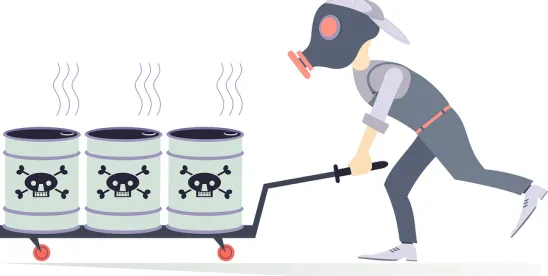The U.S. Environmental Protection Agency’s (EPA) latest attempt to replace rulemaking with enforcement is in full force, notwithstanding a spate of historic Supreme Court decisions reflecting keen frustration with federal agency statutory overreach and particular ire with the U.S. EPA. In this latest side-stepping of the Clean Air Act (CAA) and the Administrative Procedure Act (APA), EPA has endeavored to re-write, without rulemaking, the Benzene Waste Operations NESHAP (BWON) -- a rule that was last amended in 1993 – by “enforcing” new interpretations through individual, closed-door enforcement negotiations, outside the reach of the rulemaking process and judicial review.
EPA’s tactics can be summarized as follows:
- Issue policy interpretations that bear little resemblance to the actual rule;
- Inspect a few facilities and find non-compliance with those new interpretations;
- Leverage those findings to achieve large-scale settlements that include multiple extra-regulatory requirements; and
- Assert that this new settlement template is a new industry “baseline” to demand nearly identical settlements from the rest of industry.
Facing the choice between settling on EPA’s terms, or litigating EPA’s new interpretations and facing agency blow-back, most companies choose to settle. EPA knows this and holds the threat of significant, highly-public enforcement to compel companies to agree to its new interpretations through settlement.
Those who have represented industry in these enforcement-by-rulemaking cases for decades recognize that there is something fundamentally unlawful and unfair with EPA’s recent BWON Initiative. EPA’s new interpretations of the BWON approach magical thinking, and the settlement demands are staggering (tens of millions of dollars in penalties and hundreds of millions in injunctive relief based on the BPWhiting Refinery settlement). The enforcement process is opaquely presented in a single PowerPoint presentation. EPA expects immediate acceptance and is unwilling to discuss actual regulatory compliance or the cost and engineering complexities associated with the settlement demands. To make things worse, the tenor of these meetings tends to range between smug and bullying from the outstart – even when companies signal strong interest in reaching a workable settlement. Enforcement negotiations are never particularly easy, but the Agency team projects disinterest in the law, the facts, or engaging in actual negotiations.
EPA has its own vulnerabilities, however, and industry should refuse to acquiesce to these demands before the BWON enforcement initiative takes on such momentum that it is irreversible. Many of EPA’s current interpretations of the BWON would not survive judicial review, because they simply are not supported by the regulatory history, the language and structure of the rule, or EPA’s long-standing interpretations. EPA’s case development often ignores facts that demonstrate compliance with the BWON as per the rule itself, substituting them with “facts” that do not withstand the credible evidence rule. We offer four suggested strategies below.
1. Get Ready for an NEIC or BWON Inspection and Information Collection Request.
If you are a refinery or ethylene manufacturer and your site is located in an environmental justice community, you are at high risk of enforcement. Consider preparing your site for an NEIC inspection. See our tip sheets for preparing for an inspection and CAA 114 Information Collection Requests. Not all information is sought through CAA 114s, but the Company should nevertheless consider how to develop and document the administrative record when the information exchanges are less formal.
2. Consider a Third-Party Audit.
If you have not had a BWON inspection for some time, it may be worth conducting a third-party audit to identify the site’s actual non-compliance and to develop a factual record that will counter the Agency’s data and aid in enforcement defense. While a site may need to disclose audit information that indicates non-compliance on its Title V deviation report, early identification and correction of that non-compliance is preferable to initial discovery by the Agency. Early corrective action could also avoid some allegations of violations altogether – thus limiting the Agency’s leverage in future settlement negotiations. Finally, one of EPA’s demands in its BWON Enforcement Alert was for companies to conduct a third-party audit. Doing so demonstrates that the site took the Enforcement Alert seriously in advance of actual enforcement.
3. Get Ready for Difficult Negotiations: Prepare Your Technical and Legal Defenses.
EPA has a series of new stock regulatory interpretations and settlement demands that it has publicly announced that are highly objectionable. Below are some counter-arguments for some of the most aggressive agency positions:
a. The BWON Is Not a MACT Standard. The BWON was adopted under the pre-1990’s CAA Section 112. Since 1990, EPA’s HAP rules have changed, requiring continuous monitoring, detailed recordkeeping, extensive SSM plans, and the like. The BWON does not include these provisions. Yet, the Agency approaches BWON compliance as if it were a MACT standard, expecting the same level of detail in the facility’s records.
b. NDE Is Not a Continuous Operating Standard. The BWON requires equipment controlling regulated benzene waste streams to be designed to achieve no detectable emissions (NDE), as demonstrated once per year through a Method 21 reading of 500 ppm or less. EPA has redefined this requirement to establish both a design and operating standard so that any exceedance is a violation – even if the site corrected the leak and re-monitored to demonstrate emissions were below the 500 ppm threshold.
Even more critically, EPA then takes the position that any exceedance of the 500 ppm threshold means that the waste stream managed in that equipment is therefore “uncontrolled” under the BWON and that it, therefore, must be included in the site’s annual 6MG or 2MG allowance. Quite simply, there is no basis in the rule itself, the Federal Register, or the background documents for such an interpretation. Nor has EPA itself interpreted the BWON in this manner in its three decades of prior BWON enforcement – including its earlier nationwide refinery enforcement initiative, which targeted many of the very facilities that are the subject of EPA’s current enforcement efforts.
c. Leaks Are Not Violations of the BWON. In addition to characterizing design standards as continuous operating limits, EPA also claims that the 500 ppm NDE threshold is not an LDAR standard but a strict emissions limit because the BWON LDAR standards are “different.” By characterizing the NDE threshold as a limit, EPA converts any exceedance of that standard into an immediate violation – unlike LDAR programs, where detecting a leak merely triggers a requirement to initiate repairs. Once again, there is no basis in the BWON program for this position. On the contrary, the NDE requirements mirror the language developed in later LDAR programs, stating that when a leak is detected, the owner or operator must attempt to repair it within a specified timeframe (from 5 to 45 days, depending on the type of equipment). Indeed, the BWON even includes another standard LDAR term: a delay of repair provision, which authorizes continued operation of the equipment without repairing a leak if a repair is “technically impossible” without a partial facility or unit shutdown. 40 C.F.R § 61.350. This express authorization to continue operation after a leak has been detected puts paid to EPA’s claim that any such leak is never “allowed.”
d. Leaks and Emissions Events Are Not Included in a Facility’s Annual Benzene Allowance. During its initial refinery enforcement initiative, EPA demanded that the affected refineries agree to comply with the 6 BQ compliance option, not the 2 Mg option. EPA is reiterating that demand for any facilities that still rely on the 2 Mg option. This is a trap.
The 2 Mg option allows facilities to select specific streams to remain uncontrolled; all other streams must be managed in units equipped with BWON-level controls. Thus, if some equipment does not operate as it should, under the 2 Mg option, that is a direct equipment violation. The 6 BQ option functions differently. Rather than selecting streams for control, the facility treats as many streams as necessary to reach a refinery-wide total of 6 Mg benzene. Compliance with this option is measured at the entrance to the first uncontrolled unit.
This distinction appears to be immaterial; both anticipate that facilities will design their systems to install enough controls to comply with the chosen exemption. Recall, however, that EPA now claims that if one piece of equipment exceeds the NDE limit, the entire quantity of benzene managed in that unit must be added to the 6 BQ calculation. Under EPA’s theory, any NDE violation will almost inevitably lead the facility to exceed the 6 BQ threshold – converting what should be, at most, a one-time equipment violation potentially into a years-long exceedance.
The BWON does not contemplate this approach and never has. Designation of controlled and uncontrolled streams is intended to be prospective and elective: the BWON expressly allows site owners and operators to plan for compliance by determining which streams will be equipped with BWON controls and which will not. The requirement to include benzene from unforeseeable leaks and upsets eradicates this flexibility. Owners and operators could never predict which units might record an exceedance of the NDE level and how that exceedance might affect their 6 BQ calculations. Indeed, under EPA’s interpretation, a facility could switch in and out of compliance every year, depending on whether and which units recorded an exceedance of the NDE threshold, converting BWON compliance into a game of “gotcha.” EPA has never demanded this approach in the past 30 years in enforcement, regulation, or guidance. Nor has any facility that we know ever calculated its BQ in this way.
e. Compliance Methodology and Determinations Matter, and the Credible Evidence Rule Does Not Allow EPA to Circumvent its Obligation to Prove that a Violation Occurred. The BWON sets forth clear compliance methodologies and determinations for its provisions, as outlined in individual equipment standards and in the testing provisions of 40 CFR 61.355. For example, as discussed above, the NDE provisions require compliance to be determined by an annual Method 21 reading below 500 ppm. EPA’s new theories ignore these requirements, replacing them with new options, like OGI cameras and LEL standards not contemplated by the BWON (and did not exist when the rule was adopted). But it is hornbook law that compliance with a regulation must be determined by the regulation’s compliance methodology. The BWON compliance determination provisions still matter, and will matter to a court of law.
EPA may assert that its credible evidence rule allows the Agency to ignore the compliance methodologies identified in the rule. That is wrong. The credible evidence rule allows EPA to use alternative compliance testing methods to demonstrate that the facility would violate the requirement when using the compliance methods provided by the rule. Thus, for example, EPA may use a continuous opacity monitoring device to assess compliance with a 20% opacity standard, rather than having a person manually take readings under Method 9. But, the key to this permission is that the continuous monitor accurately measures the same thing that the standard requires: the percent opacity. EPA could not, on the other hand, use a continuous monitor that measures particulate matter emissions to “prove” a violation of this same 20% opacity requirement, because while some particulate matter may generate opacity, some does not. There is no accepted method to convert the particulate matter measurements into percent opacity.
OGI technology and flyovers can “see” emissions, but they cannot discern whether these emissions involve VOCs. Nor can these alternatives measure the amount of VOCs or benzene emitted, or assess whether an exception applies to authorize those emissions (e.g., a hatch on a tank can be opened when needed to take samples of the content or perform maintenance). In short, EPA’s new technologies allege a violation if the emissions “look” bad through a camera without any attempt to correlate those emissions to the requirements set forth in the BWON. This interpretation changes the stringency of BWON compliance without fair notice and in violation of the due process clause. See United States v. Mountain State Carbon, No. 5:12-CV-19, 2014 WL 131065 (N.D.W. Va. Jan. 14, 2014).
4. Consider Litigating.
EPA knows the business calculus favors settlement for many companies, and it is using that leverage to compel more expansive settlements with every new enforcement initiative. But EPA is not invulnerable. Regrettably, judicial force may be the only way EPA is forced to concede it is wrong on the law. Now is about as favorable a moment to seek judicial challenge of EPA’s regulatory and enforcement infirmities as industry has had in many years. It may take legal push-back to breath reason and reasonableness into EPA, but where the stakes are in the hundreds of millions per site, perhaps that business calculus will be different.






 />i
/>i
